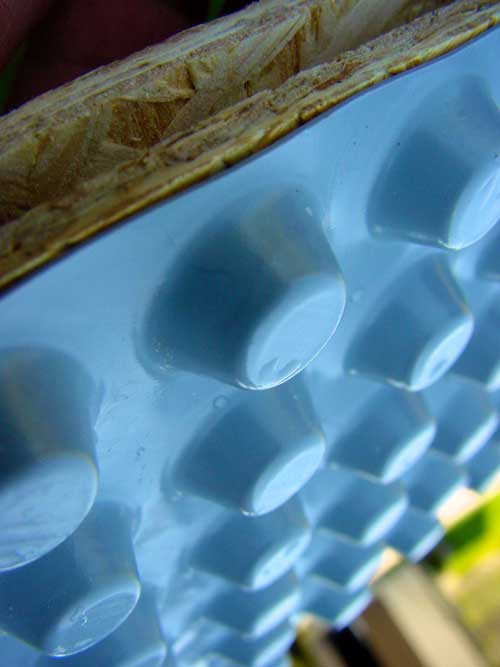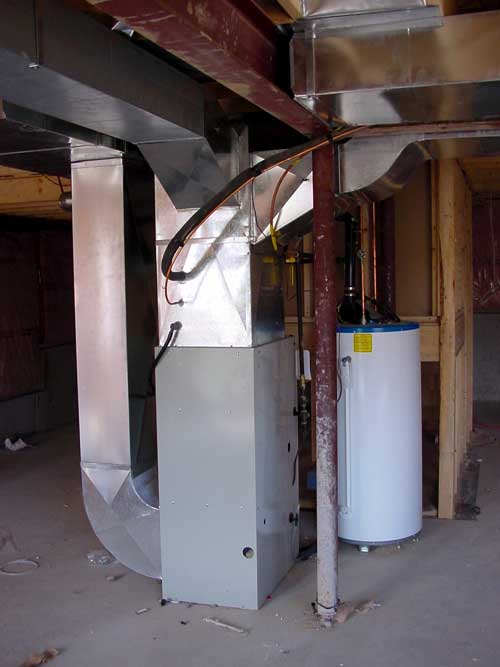While it’s true that tiny problems with your home can trigger big consequences, a little foresight can eliminate trouble before it even starts. This is especially true with finished basements and, in particular, basement floors, which are often unnecessarily vulnerable to water damage because of the way they’re built. An incident that happened this past winter at my sister-in-law’s new, custom-built house is a classic case of a snowballing home repair issue. This event has something to teach anyone with a finished or soon-to-be-finished basement.
 Beware of Leaking Furnace Drain Lines
Beware of Leaking Furnace Drain Lines
It all began when a vinyl drain tube popped off a plastic spigot coming out of the gas furnace. The installer had forced the tube onto a fitting it wasn’t designed for, and the ill-fitted tubing wasn’t clamped, either. And if this wasn’t enough, the tubing itself ran across the doorway to the furnace room – another no-no. One snag on someone’s foot and the tube quietly popped free, allowing about 20 or 30 litres of condensed furnace water to seep under a laminate floor in a neighbouring hallway over the course of a day or so. By the time someone noticed, the hall floor made squishing sounds underfoot, and seams were visibly swollen. While none of this should have happened, what occurred next is an example of how trouble snowballs.
Subfloors Can Eliminated Problems
While it’s true that more care installing the furnace drain line would have prevented the problem, basement leaks do happen. You have to expect that and build accordingly with multiple layers of safety. If the laminate floor had been installed over a raised subfloor product, the leaked water would not have been an issue. Offered by a number of manufacturers, many subfloor products are designed to allow up to 1/2-inch of water to drain away harmlessly from underneath finished floors. The fact that no such subfloor had been installed was the reason the little snowball got so much bigger.
After reporting the soggy floor to the insurance company, a mold expert arrived, then cut and removed the flooring from the hall, leaving ragged edges where the existing floors remained. While it’s prudent to be concerned about mold and moisture, I suspect the water would have dried fine without floor removal. The concrete floor was unpainted, porous and thirsty. Indeed, the squishiness was gone and the swollen edges of flooring planks had almost disappeared before the guy with the saw arrived.
 Five New Flooring Options
Five New Flooring Options
Now with the floor cut, insurance repairs were part of the deal, but how much? Naturally, my sister-in-law initially envisioned the whole laminate floor being replaced, since a simple patch in the hallway won’t match the remaining floor. But then again, perhaps a flooring upgrade is a better option.
The basement floor was never well liked, and it’s cold in winter (another issue that would have been eliminated if a subfloor had been installed in the first place). The existing floor also lacked a place for dirty winter boots near the outside basement entrance, and this led to a full-blown consideration of many options. Cost estimates for the issue were now well into five figures. Here’s the pro/con analysis on the choices, in case you’re considering a new basement floor yourself:
- Leave floor as-is, add laminate to fill open space.
- Pros:
- least expensive
- most environmentally responsible
- least disruptive
- Cons:
- punctuated look where added floor transitions to existing floor
- no increase in wintertime floor temperatures
- no place for dirty boots
- no protection against future floods
2. Leave floor as-is, fill open space, add tiled boot area near door.
- Pros:
- second least expensive
- environmentally responsible
- very little disruption
- place for dirty boots
- Cons:
- punctuated look where added floor transitions to existing floor
- no increase in floor temperatures
- no protection against future floods
3. Tear up entire floor, install subfloor product, add laminate or click hardwood.
- Pros:
- moderate cost (compared with #4 and #5)
- unified look
- moderate increase in floor temperature
- Cons:
- fairly disruptive
- fairly costly
- high environmental impact
- basement might/probably will still feel too cold (though less cold than now)
4. Tear up existing floor, install ceramic tiles, no infloor heat.
- Pros:
- tough, dirt-proof surface
- great resistance to flooding
- Cons:
- costly
- high environmental impact
- highly disruptive
- cold floor (at least as cold as now)
5. Tear up existing floor, install ceramics with electric infloor heat.
- Pros:
- tough, dirt-proof surface
- gloriously toasty toes
- super good look
- Cons:
- extremely costly
- another thing to fix (infloor heating)
- very disruptive
- very high environmental impact
In the end, after considering all the options, my sister-in-law decided to simply go with replacement of the cutaway floor, mostly because it creates the least environmental impact. But as things stand right now, that cut-out section of floor is still missing, and more than a few people have been kept busy by nothing more than a badly fitted piece of vinyl tubing. All of which proves that even the biggest snowballs sometimes start very small.
 Beware of Leaking Furnace Drain Lines
Beware of Leaking Furnace Drain Lines Five New Flooring Options
Five New Flooring Options


